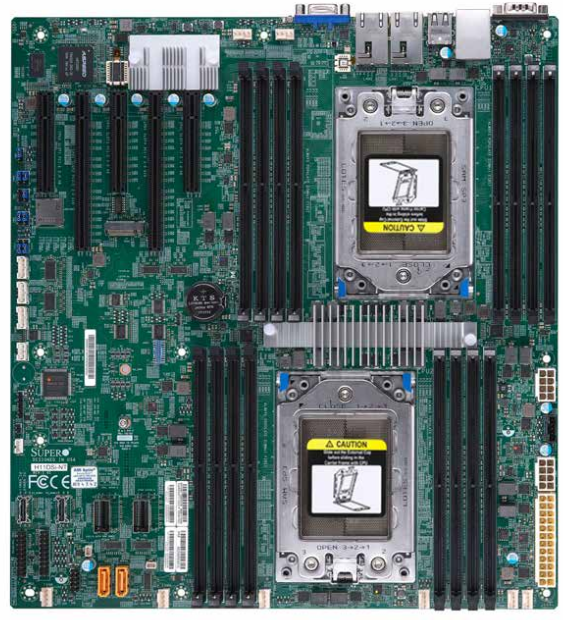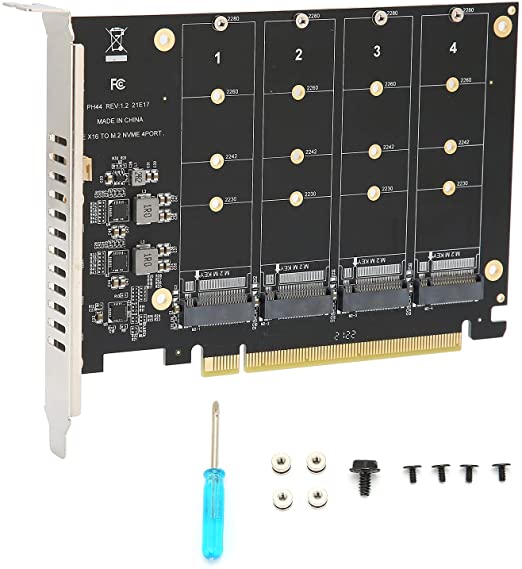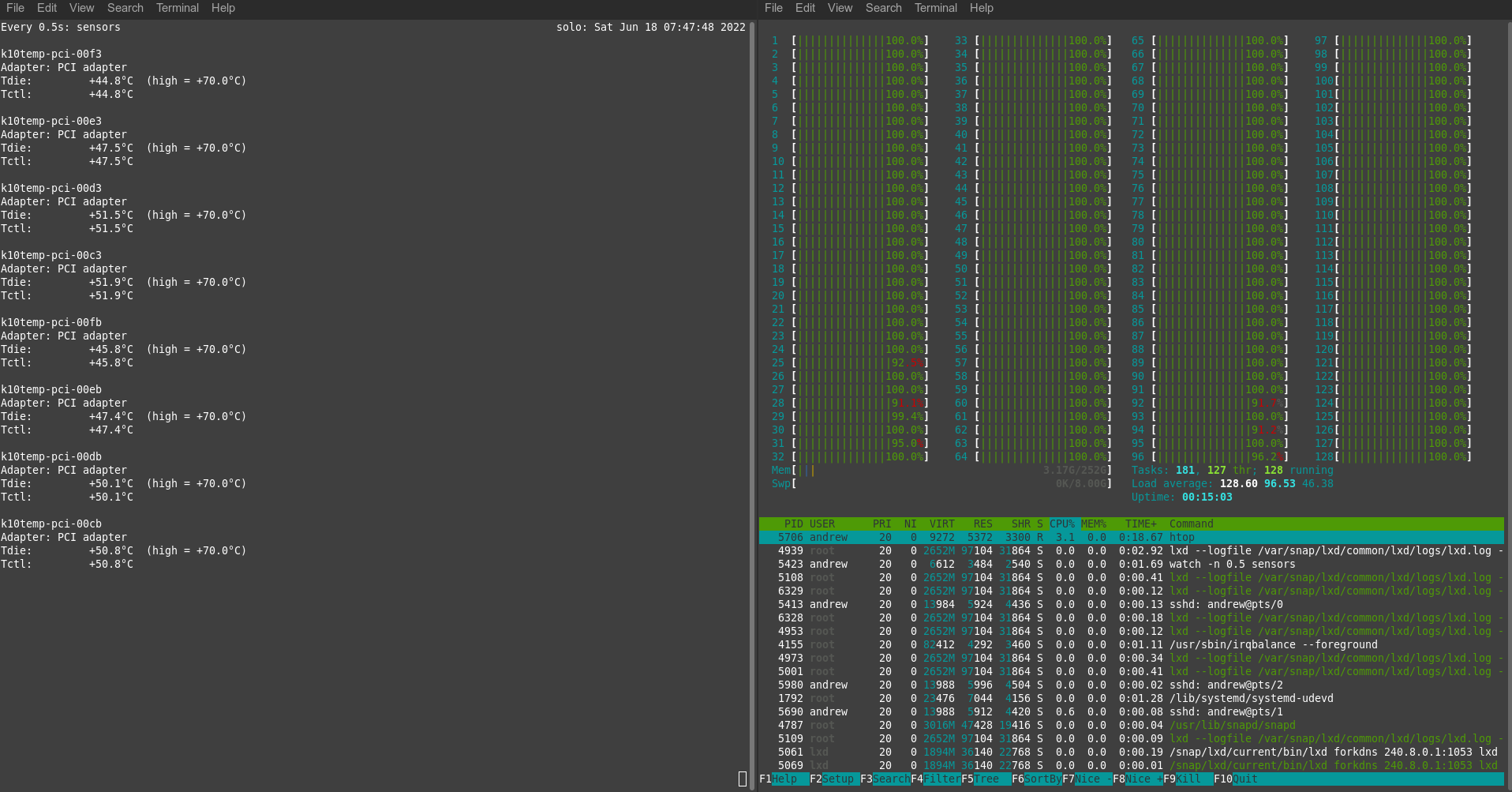TLDR; I built a dual-cpu EPYC-based server in a tower case for home networking – and it’s really cool, literally!

I have spent some time over the last few days assembling, configuring and testing my over-the-top home-server, the heart of which has dual first-generation AMD Naples 32-core EPYC 7601 CPU’s. This posting is an initial quick-look at my system – just to get something out there in case others are looking at doing something similar – there’s not a lot of homelab information on dual-core Epyc setups (probably because they are way in excess of the capabilities you need for average homelab workloads).
I have a major goal for this build of being a capable but QUIET system that fits in a home environment in a Tower with some RGB bling so it looks cool too. Hardware wise the system consists of:
- Two used AMD EPYC 7601 CPU’s – 32 cores each, 2.2 GHz base clock and up to 3.2 GHz max boost clock depending on the load/usage
- A used SuperMicro H11DS i -NT motherboard – highlights
- Dual 10G nics
- Five PCIE-3 lanes (2×16, 3×8)
- Single NVME M.2 interface (intended for OS)
- 10 Sata ports
- Modern java-free IPMI remote management interface
- And more – see manufacturer’s specs here: https://www.supermicro.com/ja/products/motherboard/H11DSi

- 256 GB ECC registered 2666MHz memory (16x16GB modules)
- Three Kingston 2-TB PCIE-3 NVME’s
- Courtesy of one of the PCIE 3.0 x16 lane that’s holding a quad NVME adapter:

- One Samsung EVO 4TB SSD
- Two Kingston 256GB NVME (one for the OS – Ubuntu 20.04 server, one for my Timeshift backups)
- Two x Noctua NH-U14S TR4-SP3 cooling fans
- All of this is housed in a Fractal Torrent E-ATX RGB case which has 2 x 180mm and 3x 140mm regular cooling fans. I went with Fractal and Noctua because I wanted very low operational noise and effective cooling, and I went with a Tower configuration and upgraded to RGB because this sits in my home office and we at home want this to look cool as it’s visible in the home space.
Back in the distant day of 2018, the CPU’s alone cost over $4k each, but AMD have had two generational releases of EPYC since then – Rome and Milan, causing the price of Naples hardware to plummet as is common. I thus got these two flagship Naples CPU’s and motherboard for $1.3k on EBay – sourced from China so I wasn’t sure what to expect, but it turns out to be exactly what I hoped I had bought. As an old-guy, getting my hands on an overpowered 64 core monster like this seems amazing given that I started with the most basic 8-bit computers that cost an arm and a leg back in the early 1980’s. For this build, I had to buy drives, memory, power supply, case etc. (all of which were new) so the total build cost is more than I want my wife to know, but I am very happy with how it is coming on.
Assembly of the system has been straighforward although it took longer than I initially expected because I needed the odd additional cable and such, but nothing that impacted actual performance (more for aesthetics). Note that the motherboard does not have connectors for some of the case front ports (usb c etc.). I will likely leave these dead, but you can buy an add on pcie card that can connect to these if required (I just run power and ethernet to my server – no keyboard, monitors or usb devices. I can access the machine via the IPMI device which is…awesome to a guy coming from using consumer motherboards for running servers)
Performance wise this has yet to be put through sustained trials, but I have already been testing and recording the power consumption (using a COTS power meter) and system temperatures under no-load and all-core loading (via simple stress-ng, htop and sensors command line utilties on Ubuntu 20.04).
Here’s a quick-look summary of some of the stress/temperatures/power-draw I am seeing in this setup:




The above is a simple summary, but it shows the excellent ventilation and cooling fans of the Torrent and the Noctua CPU coolers can easily tame this system – 48-50C for the CPU’s is well within their operating temperatures, and I may actually get better than that once I setup some ipmi fan profiles to increase system cooling under such high CPU loads. the above results were obtained under one of the standard supermicro IPMI fan profiles (“HeavyIO”), which is not especially aggressive. Noise wise, I can’t hear this system at all under ambient conditions, and barely under load. I may try to quantify that once I have everything setup.
Under load, the CPU’s do not overheat but it quickly raises the ambient temperature of my workspace a few degrees as notably warmer air emerges from the rear vents of the Fractal Torrent (I may need to beef up my AC…). I consider this just stunning cooling performance from the Torrent/Noctua’s.
Temperatures and power draw will increase as I finish out my build (more hardware/drives), but I can already see that the viability of this server setup in a Tower case is very positive.
I will use this system, once it’s finally ‘production ready’ to be the primary server for my virtualized home services.
Acknowledgements:
I spent many an hour scouring the web looking for Epyc home server / tower builds before I pulled the trigger on this used hardware. For those looking to do something equally crazy, note that there’s not a lot of information out there. Wendell at level One Tech has some excellent videos some of which go back to Epyc first-gen (e.g. here and here). Jeff at Craft Computing has several excellent videos on his Epyc home servers (e.g. here). Finally, Raid Owl has an informative and entertaining video on a more modern setup too (here). Thanks to all of you for the free, informative and entertaining content you provide! 🙂
If you have any questions, you can reach me on Twitter – Andrew Wilson, @OGSelfHosting

